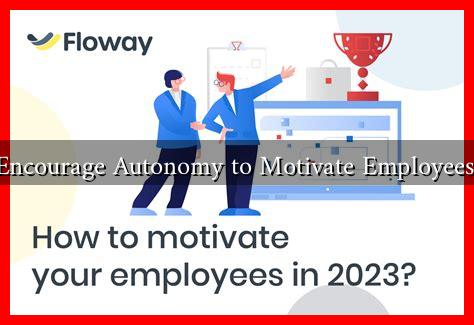-
Table of Contents
How to Encourage Autonomy to Motivate Employees in 2025
As we move into 2025, the workplace landscape continues to evolve, driven by technological advancements and changing employee expectations. One of the most effective strategies for enhancing employee motivation is fostering autonomy. Autonomy not only empowers employees but also leads to increased job satisfaction, creativity, and productivity. This article explores how organizations can encourage autonomy to motivate their workforce in 2025.
The Importance of Autonomy in the Modern Workplace
Autonomy refers to the degree of control and independence an employee has over their work. Research has shown that when employees feel they have the freedom to make decisions, they are more engaged and motivated. According to a study by Gallup, organizations that promote autonomy see a 21% increase in productivity and a 17% increase in employee engagement.
Strategies to Foster Autonomy
To effectively encourage autonomy in the workplace, organizations can implement several strategies:
- Flexible Work Arrangements: Allowing employees to choose their work hours and locations can significantly enhance their sense of autonomy. For instance, companies like GitLab and Buffer have adopted fully remote work policies, enabling employees to work from anywhere, thus fostering a culture of trust and independence.
- Empower Decision-Making: Encourage employees to take ownership of their projects by involving them in decision-making processes. For example, Google’s “20% time” policy allows employees to spend 20% of their workweek on projects they are passionate about, leading to innovations like Gmail and Google News.
- Provide Resources and Support: Equip employees with the necessary tools and resources to make informed decisions. This includes access to training, mentorship, and technology that can help them perform their tasks more effectively.
- Encourage Experimentation: Create a safe environment for employees to experiment and take risks. Companies like Amazon have embraced a “fail fast” philosophy, where employees are encouraged to innovate without the fear of failure.
- Set Clear Goals: While autonomy is essential, it should be balanced with clear expectations. Setting specific, measurable, achievable, relevant, and time-bound (SMART) goals can help employees understand their objectives while still allowing them the freedom to determine how to achieve them.
Case Studies: Successful Implementation of Autonomy
Several organizations have successfully implemented autonomy-driven strategies, leading to remarkable results:
- Atlassian: The software company is known for its “ShipIt Days,” where employees are given 24 hours to work on any project they choose. This initiative has led to numerous innovative products and features, showcasing the power of autonomy in driving creativity.
- Netflix: With its culture of freedom and responsibility, Netflix allows employees to make decisions regarding their work without excessive oversight. This approach has resulted in high levels of employee satisfaction and retention, as individuals feel trusted and valued.
Statistics Supporting Autonomy
Several studies highlight the positive impact of autonomy on employee motivation:
- A report by the Harvard Business Review found that 70% of employees who have a high degree of autonomy report being highly engaged at work.
- According to a survey by Deloitte, 94% of executives believe that fostering a culture of autonomy is essential for attracting and retaining top talent.
Conclusion: The Future of Work is Autonomous
As we look ahead to 2025, encouraging autonomy will be crucial for organizations aiming to motivate their employees effectively. By implementing flexible work arrangements, empowering decision-making, providing resources, encouraging experimentation, and setting clear goals, companies can create an environment where employees feel valued and motivated. The case studies and statistics presented in this article demonstrate that fostering autonomy not only enhances employee satisfaction but also drives innovation and productivity. In a rapidly changing work environment, organizations that prioritize autonomy will be better positioned to attract and retain top talent, ultimately leading to long-term success.
For more insights on workplace motivation and employee engagement, consider exploring resources from Gallup and Harvard Business Review.

